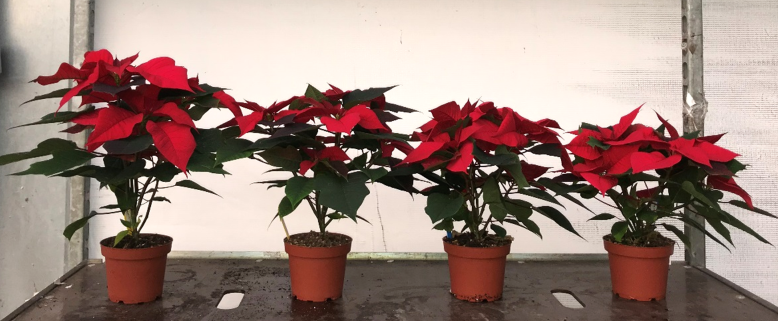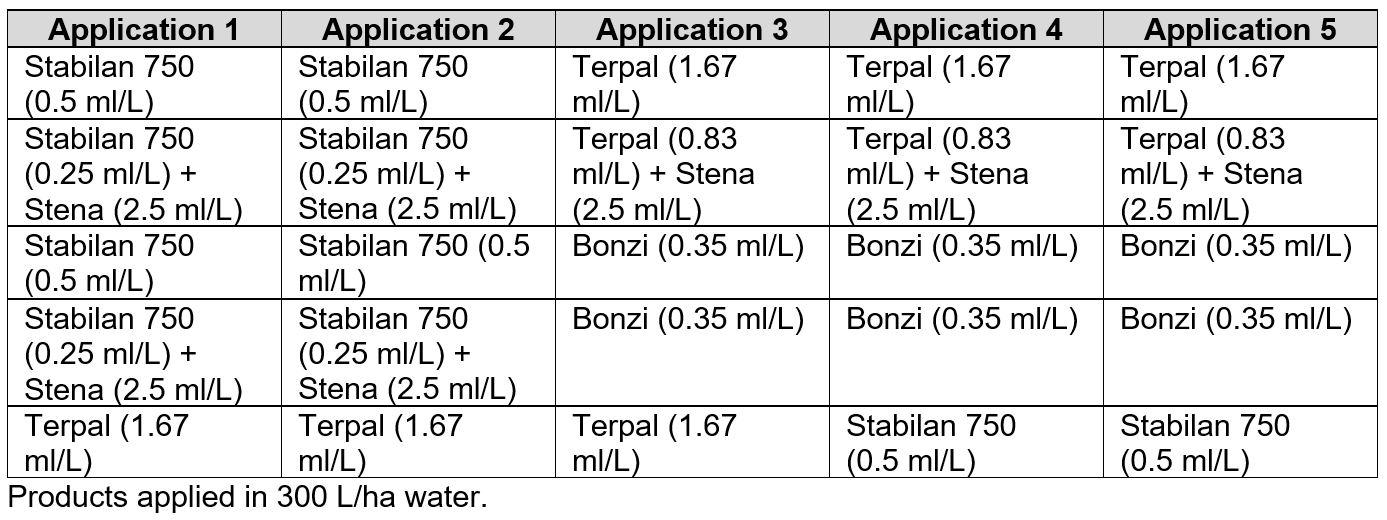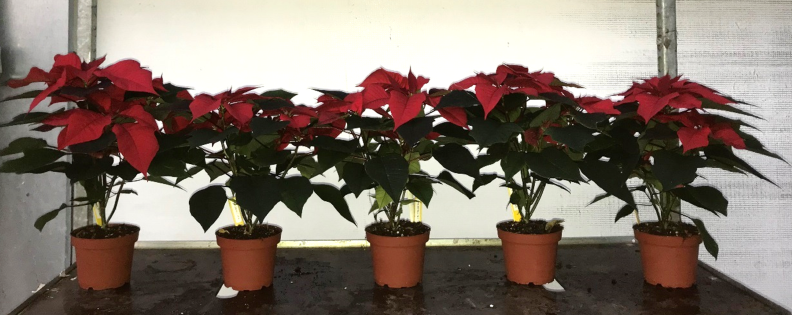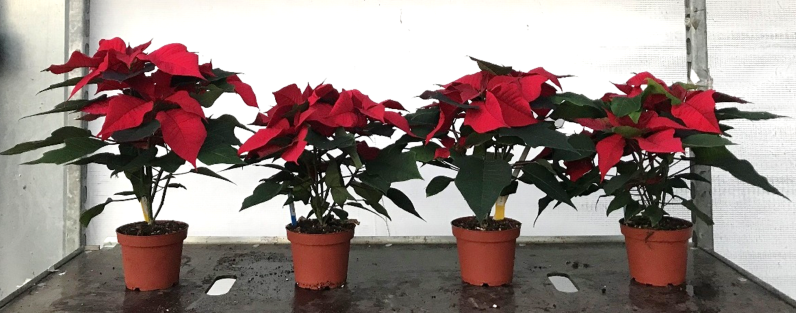Please click here to access the main AHDB website and other sectors.
- Home
- Knowledge library
- New plant growth regulators for use on poinsettia
New plant growth regulators for use on poinsettia
A number of plant growth regulators (PGRs) have recently become available for use on poinsettia and this, combined with recent changes to products containing chlormequat, have impacted the options available to control the growth of crops.
While a range of cultural methods (such as temperature manipulation and regulated water deficit irrigation) are used as growth control options, PGRs are used to help shape plants during production to achieve often challenging customer specifications regardless of environmental growing conditions. To reflect commercial practice, the new and existing PGRs were applied in different programmes and in various water volumes in trials to examine their performance. The trials produced high quality plants and gave a range of effective options to a ‘Stabilan 750 only’ PGR programme that growers can adapt for their individual growing systems and customer requirements.
Bedding and Pot Plant Centre research
Research was undertaken within the Bedding and Pot Plant Centre (BPPC) work programme to evaluate the efficacy and crop safety of a range of PGRs on poinsettia. The range of PGRs initially included in the trials was selected from promising products which had been trialled overseas or had recently received approval for use on related crops in the UK, but was subsequently expanded beyond traditional PGRs to include the new adjuvant, Stena and a seaweed-based fertiliser, Control.
The trials indicated that several of the products examined including Canopy (mepiquat (as chloride) and prohexadione calcium), Primo Maxx II (trinexapac-ethyl) and Regalis Plus (prohexadione) were not safe to use on poinsettia, having caused symptoms ranging from severe phytotoxicity, to bract bleach, with limited or no effect on growth. The products which proved effective and safe to use in the trials are summarised below.

PGR application considerations
Water volumes at application: In the Bedding and Pot Plant Centre trials, PGRs were applied in 300 L/ha water. However, higher water volumes at application are often used to propel PGRs to the furthest reaches of the crop, for example when using variable hand held sprayers such as the Ripa. If the water volume is increased when applying over the same area, the effect on plant growth will be increased as the plants will intercept more of the active ingredient; the application rate will therefore need to be reduced. The effect of different rates of Bonzi, applied in different water volumes on the growth of variety ‘Infinity’ can be seen below.

Left to right: (a). water only; (b). Bonzi, 0.35 ml/L (300 L/ha water); (c). Bonzi, 0.5 ml/L (300 L/ha water); (d). Bonzi, 0.35 ml/L (600 L/ha water). Five applications at each dose rate.
Adjuvant addition: The adjuvant Stena increases PGR uptake, allowing the application rate of Terpal and Stabilan 750 to be reduced by 40-50%. Stena is reported by the manufacturer, SurfaPlus, to be effective with daminozide products too (such as Dazide Enhance). It should be noted however, that Stena would not have a similar effect if tank mixed with Bonzi.
New products and application rates should be tested on a small number of plants prior to wide-scale use. Products applied under EAMU approval are at the grower’s own risk.
Options for poinsettia growth control
Stabilan 750 use is now limited to two applications per annum (0.5 ml/L), however it can be used as part of a spray programme that includes Terpal and Bonzi to achieve plant height specifications, with no adverse effect on plant quality, cyathia development or the number of heads per plant. Work at BPPC evaluated a number of treatment programmes as outlined below.

While the sequence of products within the spray programme should not affect plant height or crop safety, bract size can be larger when Stabilan 750 (with and without Stena) is applied first, followed by Terpal or Bonzi. Bonzi is safe to use later in production, close to bract colouring, without causing crop damage.

Left to right: (a). water only; (b). Terpal 1.67 ml/L; (c). Stabilan 750 0.5 ml/L, Terpal 1.67 ml/L; (d). Stabilan 750 0.25 ml/L + Stena 2.5 ml/L, Terpal 0.83 ml/L + Stena 2.5 ml/L; (e). Terpal 1.67 ml/L; Stabilan 750 0.5 ml/L.

Left to right: (a). water only; (b). Bonzi 0.5 ml/L; (c). Stabilan 750 0.5 ml/L, Bonzi 0.35 ml/L; (d). Stabilan 750 0.25 ml/L + Stena 2.5 ml/L, Bonzi 0.35 ml/L.
The seaweed-based fertiliser, Control, was shown to restrict plant height. It is safe and effective at the label rate (5.0 ml/L) and at double the label rate (10.0 ml/L), with no detrimental effect on plant or cyathia quality, although fewer heads may be produced at higher application rates. Rates and application frequency should be determined by small-scale trials on nurseries, prior to any commercial adoption.
Other notes in this series:
Forcing herbaceous perennials for early spring sales
Management of bought-in cutting material to retain quality
New plant growth regulators for use on pot- and pack-grown bedding plants
The use of spectral filter polythene in bedding plant production
The use of spectral filter glass coatings in the production of protected ornamentals
Have a question? Ask the team ...

Sectors:

